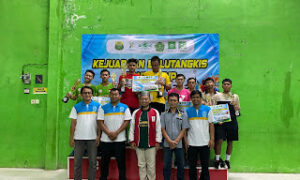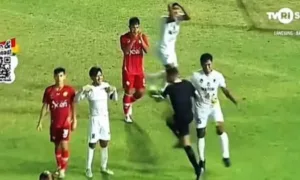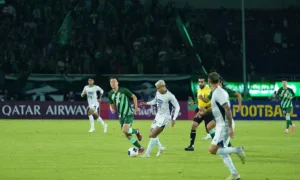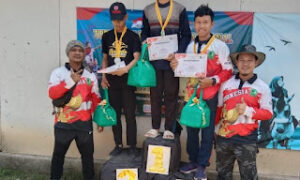by: Raphael Brandon
By definition, coaches should be able to help athletes avoid injury. Part of a coach’s job description should be to incorporate suitable injury prevention work into each training programme – for example, maintaining the correct levels of flexibility and working on core stability.
Coaches should also concentrate on making sure that injuries don’t occur during the workouts themselves. This is especially important if you coach children, because young athletes are particularly prone to developing injuries since their bodies are still maturing and bones and muscles are growing. This is especially true of chronic ‘overuse’ injuries. An overuse injury happens when an athlete performs one particular movement repeatedly and the body cannot cope with the repetitive stress associated with that movement. For example, runner’s knee is related to the repeated knee flexion as the foot strikes the ground many times during a run. The knee joint, possibly because of knee-joint mechanics, cannot cope with this repetitive stress. Young athletes commonly suffer this type of injury. For instance, ‘Little Leaguer’s elbow’ is famous in America where young baseball pitchers suffer a very high incidence of elbow tendinitis caused by repeated pitching at 80 mph at the age of 10. In the UK, shoulder injuries in young swimmers and tennis players are common (front-crawl and serving related injuries) as is knee pain.
The way to reduce the risk of children suffering injuries like this is to identify the movements or exercises which involve high forces or high repetitions and monitor the amount that these are performed. As the child develops and continues to train on a regular basis, you can gradually increase the amount that these demanding movements or exercises are carried out. It is also wise when training young athletes to allow for generous rest periods and to focus on quality, not quantity.
Take the case of Tim
The following case study is a classic example of a young athlete who suffered from an overuse injury and the rehabilitation process he had to go through to ensure the injury didn’t return. Tim is a 10-year-old tennis player of national standard. He plays between 4-8 hours a week plus one hour of fitness training. Last December he suffered a wrist injury, where the circum-stances that led to the injury were entirely related to its cause.
Tim had spent over two hours in the afternoon playing points against a friend. He then went into a one-hour tennis lesson with his coach. In the lesson, the coach concentrated on top-spin serves. The top-spin requires an extra ‘whip’ of the wrist through the ball to achieve the extra spin, and is a demanding movement. By the end of the lesson Tim’s wrist was painful and the damage had been done. Basically, his wrist joint was not strong enough to withstand two hours of friendly competition (if such a thing is possible with young athletes!) followed by a lesson which focused on one particularly demanding movement. As a result, Tim suffered an overuse wrist tendinitis injury.
The clear lesson here is that demanding movements should be concentrated into smaller coaching segments or only worked on when the athlete is completely fresh. Tim’s injury obviously wasn’t caused intentionally, but at the same time it can be considered to be the result of a ‘training error’. A training error occurs when you perform ‘too much, too soon’ or ‘too much, too tired’. Young athletes are much more sensitive to training errors, and as coaches we must therefore be as vigilant as we can.
The difficulty arises in trying to quantify what comprises a suitable training dose without falling into what could be considered as a training error. Sometimes it can be confusing trying to balance the act between not pushing young athletes too hard and treating them as though they were wrapped in cotton wool. However, it is possible to take a measured approach to training doses by thinking about how many repetitions of the movement should take place in the training session.
When we train in the gym with weights, we naturally set limits to the number of repetitions performed. We don’t allow our athletes to do bench presses for a whole workout; instead, they are unlikely to perform more than 30 reps of bench presses split up into 3-4 sets with rest periods. The same is true of a plyometric training workout. We don’t have athletes hopping around for a whole hour. Instead, they will perform something in the region of 100 foot contacts in a 45-minute workout, split up into many sets with rest periods in between.
How this applies to Tim
The answer to the problem of calculating suitable training doses is to apply the same planning to all coaching sessions that you apply to strength or power workouts. When you are coaching a movement that involves high forces, or when you are teaching a new exercise – this is demanding simply because it is unfamiliar – you need to plan in advance a fixed limit of repetitions. If Tim had hit 20 top-spin serves and then gone on to another activity, he probably wouldn’t have been injured. The next training session he could have hit 40 serves and progressed methodically from this gentle starting point. I believe that if you take this kind of measured approach you are less likely to injure your athletes during training.
To recap what I’ve been saying, to avoid injuries you need to identify the movements in your sport that involve high forces or large numbers of repetitions. Then, having identified these, you need to plan appropriate training doses based on how new the movement is and how well-conditioned the athlete is. From this starting point, you can progress the intensity or volume of training in a sensible manner. Remember, with children, if you always give them exercise in short bursts and small doses with rest intervals in between, they will probably cope very well. If you think about children’s natural activity patterns, everything they do is in short bursts of high intensity. They climb, sprint, jump, throw, and play games involving twisting and turning – all demanding movements, but performed in short bursts. Whereas adults, when they want a leisure activity are more likely to go for a five-mile continuous run, children will perform multiple sprints with rest periods over the course of an afternoon’s play. You don’t need to be frightened of teaching children demanding tasks or movements – just don’t give them too many, and always allow generous rest periods. This way you will reduce most injury risks.
Rehabilitating Tim
Having analysed the causes of Tim’s injury and the implications of training errors, a synopsis of Tim’s rehabilitation period is also a very good example of what can happen when trying to recover from an injury.
After his injury occurred, Tim rested from tennis for a few days. When he tried to play again, the pain returned. He then rested again and then played again, with the same result.
At this point he visited a physiotherapist for treatment. By then Tim’s parents were increasingly concerned about the persistent recurrence of pain and accepted my recom-mendation that Tim should rest completely from tennis and simply do general PE at school and fitness training until his wrist was 100% perfect. Sometimes it is very difficult to persuade young athletes to take a proper rest from their sport, but it is essential to give the developing body a proper chance to heal completely. For Tim, since it was his dominant hand, the healing process was probably slowed down by the fact that he couldn’t avoid using his wrist in daily life, which meant he had to be extra patient.
As for rehabilitation exercises, Tim performed regular stretching exercises for the wrist and forearm muscles, and after a three-week complete rest when the pain had gone I gave Tim a wrist-extension exercise to perform each day at home. This was done with a 1 kg dumbbell with the aim of building the strength in his wrist. After a further, precautionary fortnight, Tim played tennis for the first time, but only for five minutes. There was no adverse reaction to this session so he repeated the five-minute hit three times during that first week. The following week he played tennis three times for 10 minutes each session, and the next week he played three times for 20 minutes. During this week the wrist began to bother him again, and I asked whether he had kept up the wrist-strength exercises and he said he hadn’t. He reintroduced the exercises and the wrist has been fine ever since. After another week, Tim was able to complete an hour of normal tennis lessons.
The whole process took about two months before Tim could compete again. This involved some tough decisions on his part, to be patient and not to play again for what must at his age have seemed an eternity. In addition, further patience was needed in order to progress back into tennis very slowly. I often see young athletes taking only the minimum rest until the pain subsides before resuming a full training schedule, with the frequent result – a recurrence of the injury.

Terimakasih telah membaca di Aopok.com, semoga bermanfaat dan lihat juga di situs berkualitas dan paling populer Piool.com, peluang bisnis online Topbisnisonline.com dan join di komunitas Topoin.com.



















